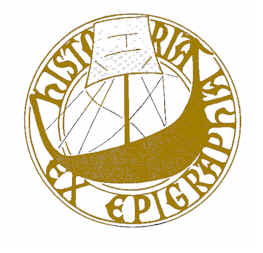
The Epigraphic Society

|
The Epigraphic Society
|
|
|
Epigraphic
Society Occasional Publications
Paper No.
Society of
Inter-Celtic Arts and Culture (1 p) Books In the Irish
language, and other Irish texts (1 p) Books on
Cryptography (1 p) Membership (12 pp) Instructions to
authors (1 p)
116
Ogam Arabic Inscriptions in North and South Africa (4 pp) Barry Fell
117
Late Roman Inscription from the Canary Islands (4 pp) Barry Fell
6/1-p 27
118
Tamacheq, a Living Dialect of Libyan (4 pp)
Barry Fell
119
Berber Roots in Polynesian (8
pp) Barry Fell
120
An Ancient Libyan Mariner's Prayer (2
pp) Barry Fell
6/1-p 43
121
A Basic Egypto-Polynesian Word List (40 pp) Barry Fell
122
An Inscription of King Masinissa ca 138 B.C. (4 pp) Barry Fell
123
Arab Horse-Racing in Ancient Libya (4 pp)
Barry Fell
124
Petroglyphs on St John (US Virgin Islands) (4 pp)
Barry Fell
125
Plague and Cat Worship in Ancient Libya (4 pp)
Barry Fell
126
Hunting Inscriptions of the Ancient Libyans (8 pp) Barry Fell
127
Libyan Evidence in Southeast Kentucky (6 pp) Warren
J. & Annette E. Calhoun
128
Sculptures Bearing Libyan-Ogham Inscriptions (2 pp) Barry Fell On
the Cover
Petroglyph
of a Zebra from the Transvaal, accompanied by an ogam descriptive comment in
Libyan Arabic, one of a series of ancient African inscriptions that make use of
the ogam consonantal alphabet. 0gam consaine, or "ogam without vowels"
occurs in the oldest Irish inscriptions, on the mainland of Europe, in Africa
and in North America. It was first recorded from Ireland by Roghan Ruadh ua
Suilleabhain, and noted by the Irish lexicographer Padraig Dineen in 1901, 1927
and subsequently overlooked until American examples were recognized in 1975.
English archeologists deny the existence of any kind of ogam other than the one
variety studied in the nineteenth century. |
Send mail to donalbb@epigraphy.org
with
questions or comments about this web site.
|